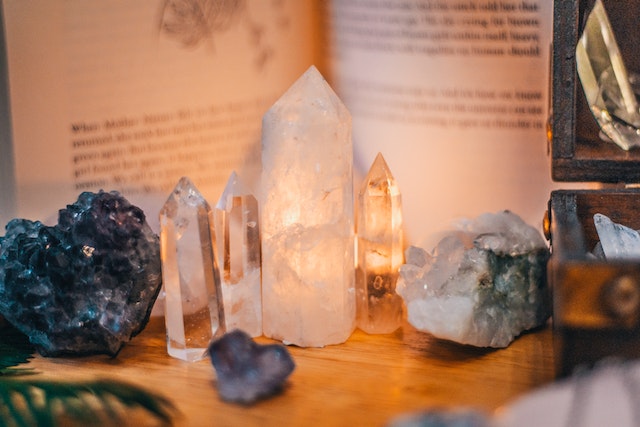How To Clean Geodes?
It is with great pleasure that I welcome you to howitpossible.com, your trusted source of practical guides and information on a variety of topics. This article is meant to bring to light the fascinating world of geodes and teach us what we need to know about cleaning them effectively. Geological formations called geodes exist within a hollow cavity in which there is a collection of beautiful crystal formations. Taking the time to clean geodes enhances their natural beauty, but it also helps to remove dirt, debris, and mineral deposits that may build up over time and contribute to their natural beauty. Our team at howitpossible.com understands the importance of proper geode cleaning techniques, and in this comprehensive guide, we will provide you with step-by-step guidelines on how to clean your geodes in the most effective manner. We have provided you with a number of recommendations on how to preserve your geode collection and highlight its unique beauty by following our recommendations. We will delve into the world of geode cleaning and learn how we can take care to preserve their brilliance as well as their allure by following the safest practices.
What is Geodes?
A geode is a unique kind of geological formation that can be found in a variety of parts of the world. A crystalline void is basically a hollow cavity within a rock that contains beautiful crystal formations or layers of mineral deposits that are within. It is possible for geodes to be as small as a single palm size rock, or as large as massive formations several feet in diameter and upwards.
It is the hollow space that is made within a rock which leads to the formation of geodes. It is possible to form volcanic mountains, sedimentary rock formations, as well as minerals dissolving over time. The hollow space formed over time is filled with mineral-rich water that seeps inside of it and deposits minerals on its walls along with the water. As mineral crystallization takes place over thousands or millions of years, intricate and unique formations occur within the geode as a result of the accumulation of minerals.
Crystals can be found in geodes in an abundance, such as quartz, amethyst, agates, calcites, and a number of other types of crystals, each featuring their own distinct colors and patterns. Although a geode’s exterior may seem unremarkable, with its appearance similar to that of a plain rock, what really makes them stand out is the many surprises and beauty they hold within their inside cavities.
Among collectors of natural goods and rock enthusiasts, geodes are highly prized for their natural beauty, as well as their rarity. It is common to cut them open or break them in order to reveal the stunning crystal formations that are inside. There is also an extensive use of geodes in the field of jewelry making, home decor, and educational settings, as well as as display pieces.
There is something captivating about discovering the world of geodes and all of their hidden treasures and seeing the wonders of Earth’s geological processes and the beauty that lies beneath the surface of our planet as you explore the wonders of geodes.
How To Clean Geodes – Step by Step instructions
It is important to handle geodes carefully when cleaning them in order to preserve their natural beauty. The following steps will help you to clean your geodes effectively, and will help you to clean them safely:
- Preparing the cleaning area:
- If you wish to clean your geodes, you should choose an area where there is good ventilation and adequate lighting.
- In order to avoid any damage to the surface of your work area, it is recommended that you lay down a protective mat or towel.
- Removing loose debris:
- Remove any loose dirt, sand, or debris from the geode’s surface gently using a soft-bristled brush or toothbrush with a soft bristle.
- While brushing the geode, it is very important to avoid scratching or damaging it.
- Soaking the geodes:
- Warm water should be placed in a basin or container.
- It is important to ensure that the geodes are fully covered in water before submerging them.
- To loosen any stubborn dirt or mineral deposits on the geodes, let the geodes soak for around ten to fifteen minutes.
- Cleaning the geode exterior:
- The geode should be scrubbing with a soft brush or toothbrush after it has been soaked for some time.
- To make the cleaning process even more effective, you can add a small amount of mild dish soap to the water in the bucket.
- It is recommended that you gently scrub the geode in a circular motion, paying special attention to any areas that are stained or dirty.
- In order to prevent the geode’s surface from being damaged, it is advisable to avoid using abrasives or harsh chemicals.
- Removing mineral deposits:
- There is a cleaning solution that can be made using equal parts of white vinegar and water, which can be used to remove stubborn mineral deposits.
- The affected areas of the geode can be gently rubbed with a soft cloth or sponge dipped in the solution.
- In order to remove any vinegar residue from the geode, we recommend rinsing it thoroughly with clean water.
- Drying the geodes:
- As soon as the geodes have been cleaned, they should be carefully removed from the water.
- Using a soft towel or paper towel to dry them naturally will help reduce the amount of time it takes to dry them.
- It is recommended to avoid using heat sources, as well as direct sunlight, as these may cause discolouration or damage to the material.
- Polishing (optional):
- Using a rock polishing compound will increase the shine and luster of your geodes and help them to exhibit their true beauty for longer periods of time.
- A soft cloth should be used and the compound should be applied to the cloth and gently rubbed across the surface of the geodes in a circular motion.
- The best way to achieve the best results with polishing compound is to follow the instructions provided with it.
- Final inspection and storage:
- If there are any spots or dirt still present on the geodes after they have completely dried, inspect them for them.
- Clean specific areas of the house if necessary by repeating the cleaning process.
- Please make sure you store your geodes properly after cleaning them in a dry and safe place that is protected from excessive humidity or temperature changes.
Keeping in mind that every geode is unique, based on its composition and fragility, some will require different cleaning methods or precautions depending on how they are cleaned. For those of you who have valuable or rare geodes that require specialized cleaning techniques, it is important that you handle them with care and consult with experts or professionals before beginning the cleaning process.a
Geodes Have A Number Of Benefits That You Should Know About
You can benefit in a variety of ways from geodes and they offer several benefits, including:
-
Natural Beauty: One of the most recognizable features of geodes is their exquisite and captivating beauty. Whether you’re adding geodes to your home or personal collection, you’ll enjoy their intricate crystal formations and vibrant colors, making them an excellent addition to your home and collection.
-
Stress Relief and Relaxation: Geodes can be a soothing and relaxing experience for many people, especially when they are exploring and appreciating them. In conjunction with a sense of tranquility and a sense of relaxation, it is beneficial to examine the unique patterns and textures within geodes.
-
Connection to Nature: Geodes are natural creations which are formed by geological processes over millions of years. As a geodes enthusiast, not only can you establish a deeper connection with the natural world, but you can also gain a deeper appreciation for the Earth’s remarkable capacity to create such wonderful formations, as a result of owning and admiring geodes.
-
Educational Value: Geodes provide children and adults with a variety of educational opportunities. You can enhance your understanding of geology and Earth’s geological history by exploring the science behind geodes and by learning about the minerals and crystals that have been found within them.
-
Decorative and Creative Use: You can put geodes to use both in your home and office to create striking decorative pieces. A wall art piece can add a special touch to the decor of your home and can serve as a conversation starter as well. Geodes can also be incorporated into many different artistic and creative projects, including jewelry-making and crafting, providing you with the opportunity to express yourself creatively through the creation of your own jewelry.
-
Mindfulness and Mindful Living: Geodes have a natural beauty that can impart a sense of mindfulness and a greater sense of being in the moment through interaction with them and appreciating them in their natural state. This gives you the opportunity to really slow down, observe the details, and immerse yourself in the beauty of nature as it unfolds before you.
-
Connection with History: Geodes are a type of geological artifact that were formed over a long period of time as the result of mineral formation. You have the opportunity to gain a sense of connection to the ancient past by owning and studying geodes, and you will also be able to marvel at the processes that changed our planet throughout history as a result.
You have to keep in mind, however, that the benefits of geodes may differ according to your personal beliefs, but nonetheless, they offer you a chance to appreciate the wonders of nature, to promote relaxation, to stimulate curiosity, and to positively enhance your overall well-being.
Frequently Asked Questions – How To Clean Geodes
Q1: How often should I clean my geodes?
A: Depending on the condition of your geodes and your personal preferences, you may want to clean them more frequently. The idea of cleaning your geodes is a good idea if they appear visibly dirty or have mineral deposits accumulated on them, or if they are visibly dirty. It may be sufficient for regular maintenance if you perform a light dusting or a gentle wipe-down on a regular basis.
Q2: Can I clean my geodes with water and soap?
A: I would recommend that you clean your geodes with water and a mild dish soap in order to keep them clean. As a result, dirt and grime can be removed from the surface more easily. To remove any soap residue that has remained on them after washing them, make sure you rinse them thoroughly afterward.
Q3: How do I remove stubborn mineral deposits from my geodes?
A: You can create a cleaning solution by mixing equal parts of water and white vinegar together in order to remove stubborn mineral deposits. In order to remove the tarnish from the geode, rub the diluted solution gently on the affected areas with a soft cloth. In order to get rid of any vinegar residue that might remain after rinsing, use clean water.
Q4: Can I use abrasive materials to clean my geodes?
A: The best way to protect the surface of your geodes is to avoid using abrasive materials or harsh chemicals that may damage the surface. When it comes to cleaning up your teeth, try using brushes, toothbrushes, or soft cloths made from soft bristles.
Q5: Should I polish my geodes after cleaning?
A: Depending on your preference, polishing your geodes may be an optional step. The surface of the rock can be lightly buffed with a soft cloth, a specialized rock polishing compound, and a soft cloth if you desire a higher shine or luster. The best way to achieve the best results with polishing compound is to follow the instructions that come with it.
Q6: How should I store my cleaned geodes?
A: It is recommended to store your cleaned geodes away from excessive humidity or fluctuating temperatures in a dry and safe place. To ensure they are protected from dust and scratches, you might want to wrap them with soft cloths or tissue papers.
Q7: Can I clean geodes that are already cut open?
A: If you have cut your geodes open, it is possible to clean the exposed surfaces. The same cleaning steps should be followed on the inner surfaces of the tank in order to prevent any mineral deposits from collecting there.
Q8: Should I seek professional help for cleaning valuable or delicate geodes?
A: In the event that you have delicate and valuable geodes, it is highly recommended that you consult with a professional or expert in geology or lapidary services. Depending on the type of geode, they will be able to provide specialized cleaning techniques and ensure that it is properly handled.
Q9: How do you deep clean crystals?
A: It is possible to deeply clean crystals by mixing warm water with a mixture of dish soap in order to clean them thoroughly. If the crystals are soaked in the mixture for a few minutes, they need to be rinsed off with warm water afterward. If any dirt or grime is found on the crystals, you can also scrub them with a toothbrush in order to remove it.
Q10: How do you polish rocks by hand?
A: It is necessary to have a few basic supplies on hand in order to polish rocks by hand, including a rock tumbler, grit, water, and a container in which to hold the rocks. Let the rocks soak in the water for a few hours after adding the grit to the water. When all of the items have been placed into the tumbler, it is time to turn it on. Add more grit and water to the pot as needed over the next few days as it runs. After you have finished cleaning the rocks, remove them from the water and allow them to dry.
Q11: How do you clean crystal rocks by hand?
A: Despite the fact that there are a variety of ways to clean crystal rocks, there is no one definitive method. It is recommended by some people that you use a mild soap and water solution, while others recommend that you use a vinegar and water solution. There are also commercial cleaners that are specifically designed for cleaning crystals, which can be used to clean the crystals. Whatever method you choose, make sure you rinse the rocks thoroughly afterwards after cleaning them, so that all of the cleaning solution is removed from the rocks.
Q12: How can you tell a crystal from a rock?
A: Crystals are symmetrical in shape, as opposed to rocks, which are asymmetrical. In addition, they are often smooth and translucent with a smooth surface.
Q13: What happens when you put lemon juice on the rock?
A: There are some minerals that can be dissolved with lemon juice because lemon juice is a weak acid. Putting lemon juice on a rock will cause the lemon juice to dissolve the minerals within the rock as soon as it is put on the rock. As a result, over time, a hole can develop in the rock as a result of this process.
Q14: How do you tell if a rock has a crystal inside?
A: There are a few simple methods you can use to determine if the rock you are looking at has crystals inside of it. Firstly, you need to look carefully at the rock and see if there are any shiny areas that you can locate on it. It is possible that these are crystals. Another way to check whether the rock is smooth or rough is to feel it to see if it feels smooth or rough to you. The feeling of roughness may be an indication that there are crystals inside the object. In the end, you might be able to scratch the rock with a sharp object in order to get a better result. There could be crystals inside if it makes a scratch on the surface.
Q15: Does bleach clean rocks?
A: In regards to cleaning surfaces and removing stains, bleach is a chemical compound that is used as a cleaning agent. However, it should be noted that while it is an effective way for rock cleaning, it can also be harmful to both the environment and human health. Therefore, when it comes to the cleaning of rocks, it is recommended that you use a more environmentally-friendly alternative.
Q16: How do you clean rocks without a tumbler?
A: If you want to clean rocks without using a tumbler, there are a few methods you can use. There are several ways to polish rocks, one of which is to use a rock polisher. This is a machine that is used to polish rocks using water and sand as the polishing agent. To remove rough edges from the rocks, you can use a rock saw to cut them off or you can use a rock saw to cut them off. It is also possible to break down the rocks into smaller pieces by using a rock hammer or by breaking them with a hammer.
Q17: Does CLR clean rocks?
A: The following is a list of some ways in which you can clean rocks without a tumbler. There are many ways to polish rocks, one of which is by using a rock polisher. Sand and water are used in this machine as a means of polishing rocks. There is another way of removing the rough edges from the rocks that is using a rock saw in order to cut them off. As a last resort, you can also break down the rocks into smaller pieces by using a rock hammer.
Q18: Can you clean rocks with hydrogen peroxide?
A: It is true that hydrogen peroxide can be used to clean rocks. There is no better way to remove dirt or stains from the rocks than to use this method. The hydrogen peroxide should first be tested on a small section of the rock to make sure the surface is not damaged when the hydrogen peroxide is applied.
Q19: What happens when you put vinegar on rocks?
A: Over the course of time, a solution formed by the vinegar will dissolve the limestone in the rock, causing the rock to erode as a result.
Q20: What to soak rocks in to clean them?
A: The best way to clean rocks is to use one of a few different methods. It is possible to soak them in a solution that consists of vinegar and water in order to remove them. There is also the option of soaking them in a solution of bleach and water in order to remove the stains.
Q21: Do all geodes have crystals inside?
A: Geodes do not always contain crystals inside of them, but many of them do. A geode is formed when a gas bubble gets trapped within hot lava or ash, and the outside of the bubble cools and hardens, while the inside remains molten as the bubble cools and hardens. The minerals in the bubble are slowly absorbed by the surrounding rock and crystallize as a result, forming a geode over time.
Q22: Where are most geodes found?
A: It is interesting to note that geodes can be found everywhere around the world, but they are most commonly found in deserts and volcanic areas.






